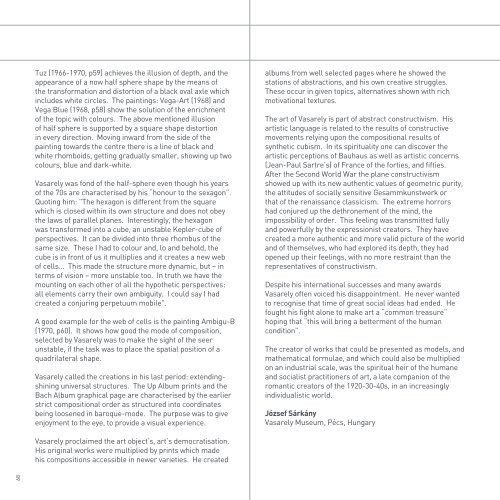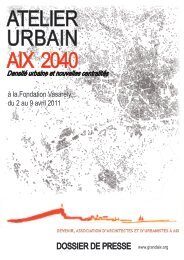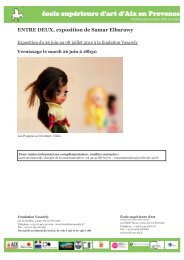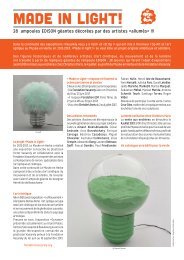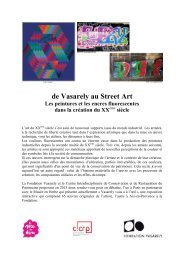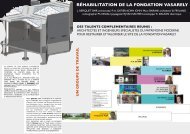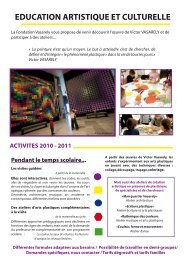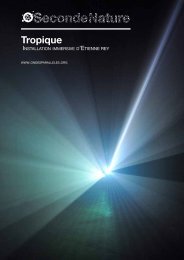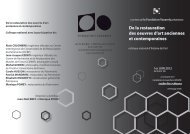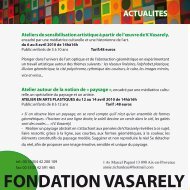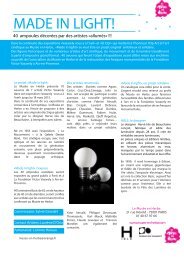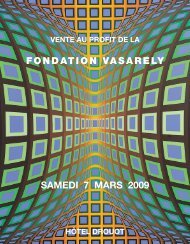Victor Vasarely - Fondation Vasarely
Victor Vasarely - Fondation Vasarely
Victor Vasarely - Fondation Vasarely
You also want an ePaper? Increase the reach of your titles
YUMPU automatically turns print PDFs into web optimized ePapers that Google loves.
68<br />
Tuz (1966-1970, p59) achieves the illusion of depth, and the<br />
appearance of a now half sphere shape by the means of<br />
the transformation and distortion of a black oval axle which<br />
includes white circles. The paintings: Vega-Art (1968) and<br />
Vega Blue (1968, p58) show the solution of the enrichment<br />
of the topic with colours. The above mentioned illusion<br />
of half sphere is supported by a square shape distortion<br />
in every direction. Moving inward from the side of the<br />
painting towards the centre there is a line of black and<br />
white rhomboids, getting gradually smaller, showing up two<br />
colours, blue and dark-white.<br />
<strong>Vasarely</strong> was fond of the half-sphere even though his years<br />
of the 70s are characterised by his “honour to the sexagon”.<br />
Quoting him: "The hexagon is different from the square<br />
which is closed within its own structure and does not obey<br />
the laws of parallel planes. Interestingly, the hexagon<br />
was transformed into a cube, an unstable Kepler-cube of<br />
perspectives. It can be divided into three rhombus of the<br />
same size. These I had to colour and, lo and behold, the<br />
cube is in front of us it multiplies and it creates a new web<br />
of cells… This made the structure more dynamic, but – in<br />
terms of vision – more unstable too. In truth we have the<br />
mounting on each other of all the hypothetic perspectives:<br />
all elements carry their own ambiguity. I could say I had<br />
created a conjuring perpetuum mobile".<br />
A good example for the web of cells is the painting Ambigu-B<br />
(1970, p60). It shows how good the mode of composition,<br />
selected by <strong>Vasarely</strong> was to make the sight of the seer<br />
unstable, if the task was to place the spatial position of a<br />
quadrilateral shape.<br />
<strong>Vasarely</strong> called the creations in his last period: extendingshining<br />
universal structures. The Up Album prints and the<br />
Bach Album graphical page are characterised by the earlier<br />
strict compositional order as structured into coordinates<br />
being loosened in baroque-mode. The purpose was to give<br />
enjoyment to the eye, to provide a visual experience.<br />
<strong>Vasarely</strong> proclaimed the art object’s, art’s democratisation.<br />
His original works were multiplied by prints which made<br />
his compositions accessible in newer varieties. He created<br />
albums from well selected pages where he showed the<br />
stations of abstractions, and his own creative struggles.<br />
These occur in given topics, alternatives shown with rich<br />
motivational textures.<br />
The art of <strong>Vasarely</strong> is part of abstract constructivism. His<br />
artistic language is related to the results of constructive<br />
movements relying upon the compositional results of<br />
synthetic cubism. In its spirituality one can discover the<br />
artistic perceptions of Bauhaus as well as artistic concerns<br />
(Jean-Paul Sartre’s) of France of the forties, and fifties.<br />
After the Second World War the plane constructivism<br />
showed up with its new authentic values of geometric purity,<br />
the attitudes of socially sensitive Gesammkunstwerk or<br />
that of the renaissance classicism. The extreme horrors<br />
had conjured up the dethronement of the mind, the<br />
impossibility of order. This feeling was transmitted fully<br />
and powerfully by the expressionist creators. They have<br />
created a more authentic and more valid picture of the world<br />
and of themselves, who had explored its depth, they had<br />
opened up their feelings, with no more restraint than the<br />
representatives of constructivism.<br />
Despite his international successes and many awards<br />
<strong>Vasarely</strong> often voiced his disappointment. He never wanted<br />
to recognise that time of great social ideas had ended. He<br />
fought his fight alone to make art a “common treasure”<br />
hoping that “this will bring a betterment of the human<br />
condition”.<br />
The creator of works that could be presented as models, and<br />
mathematical formulae, and which could also be multiplied<br />
on an industrial scale, was the spiritual heir of the humane<br />
and socialist practitioners of art, a late companion of the<br />
romantic creators of the 1920-30-40s, in an increasingly<br />
individualistic world.<br />
József sárkány<br />
<strong>Vasarely</strong> Museum, Pécs, Hungary


